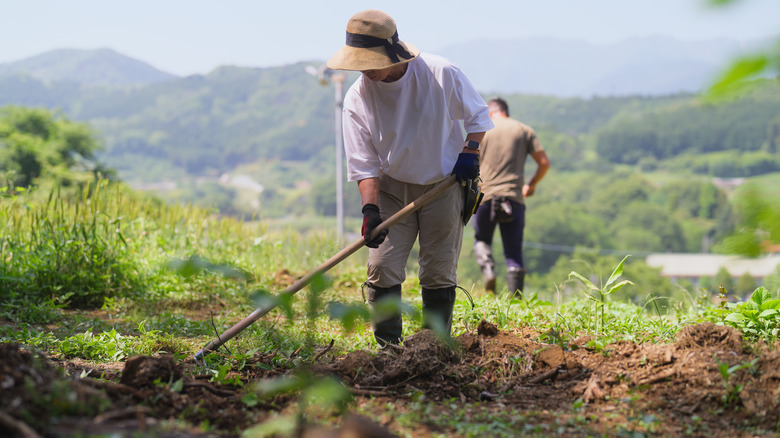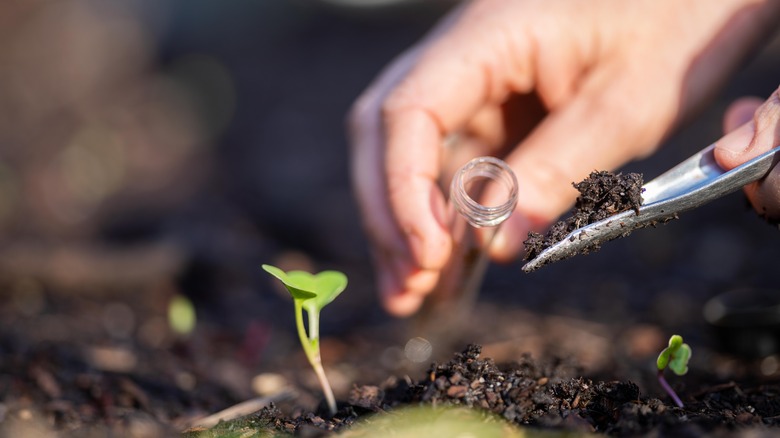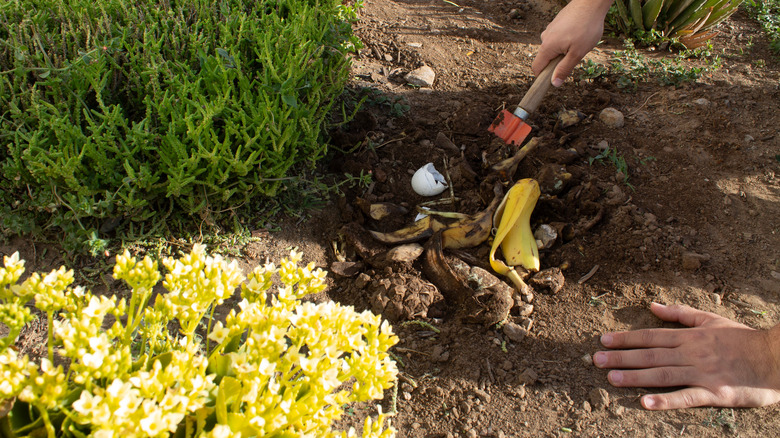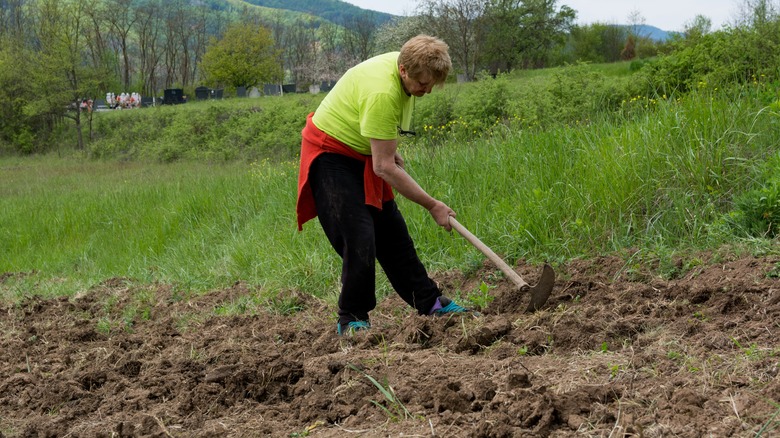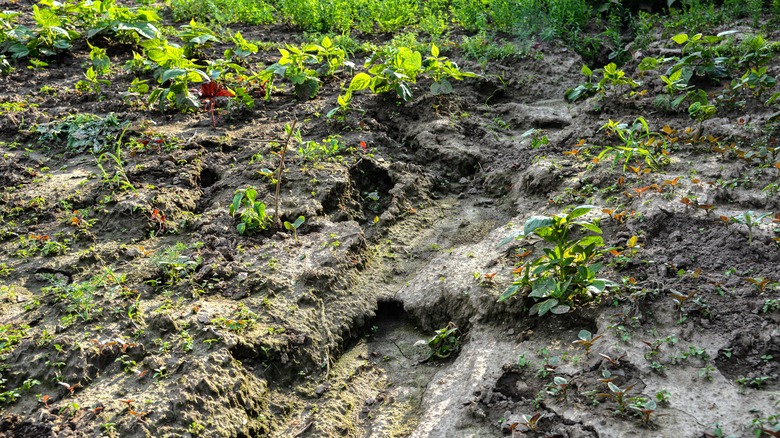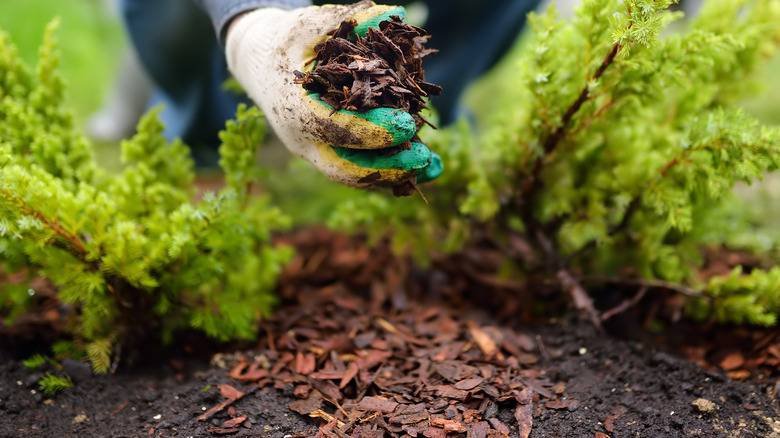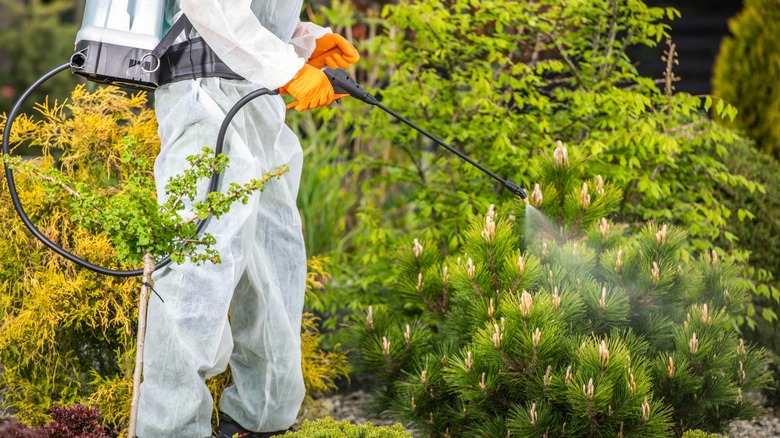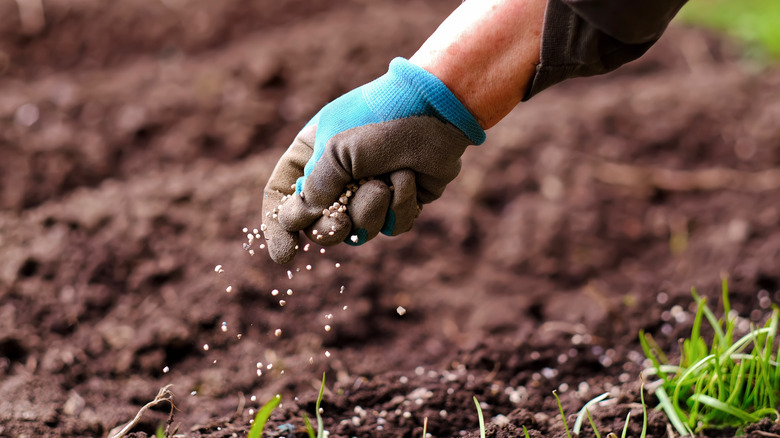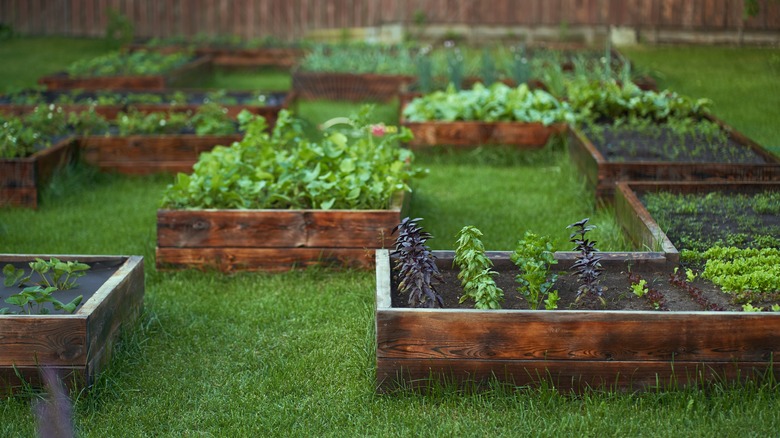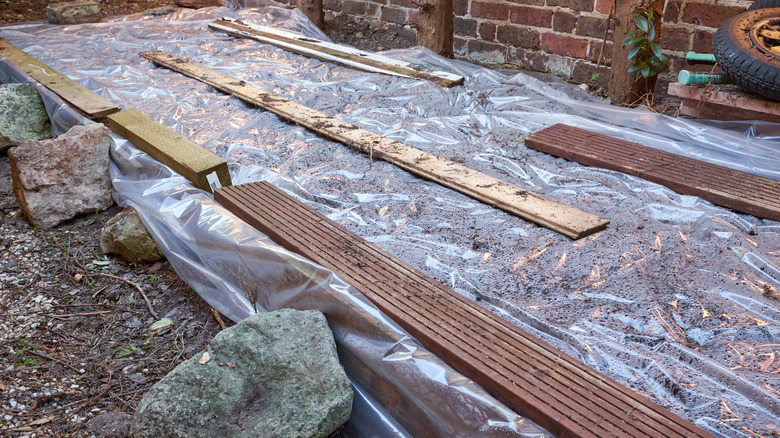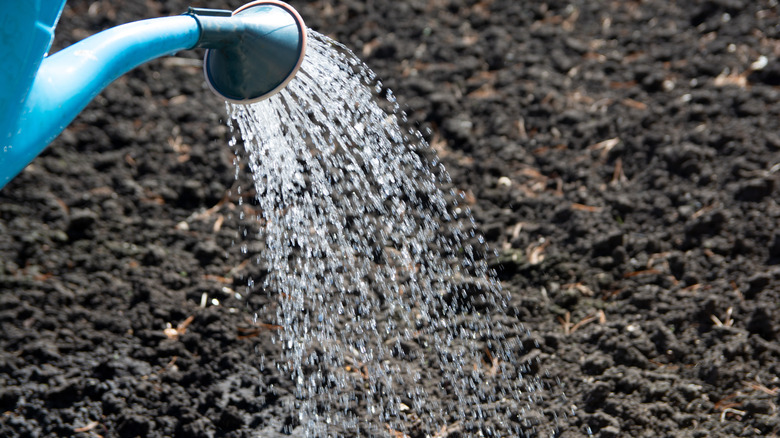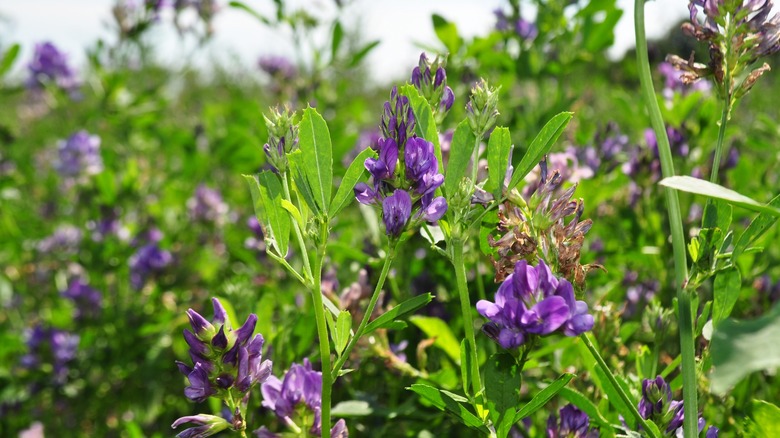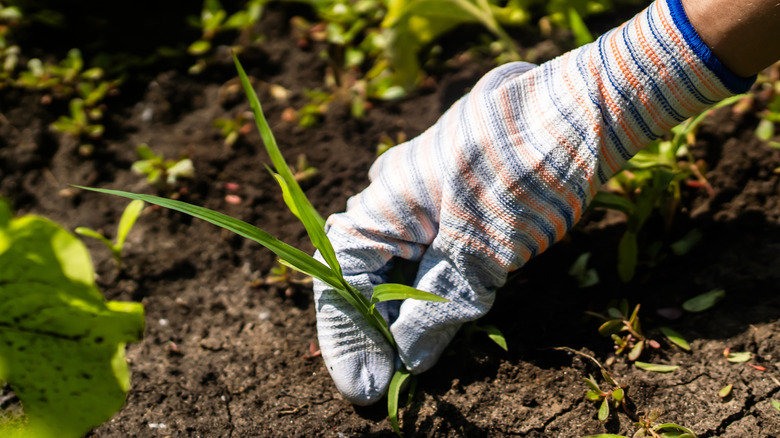How To Prep Your Soil For Successful Planting
When it comes to gardening, preparing your soil before you plant often gets overlooked when you plan out your garden. However, the secret to growing healthy plants is under the surface, in the unseen world of soil prep and health. Ideally, you'll do a deep dive into your garden soil to ensure you take steps to make it a solid foundation for your plants to thrive all season. You should do several things to prepare your soil, from testing your pH levels to improving the soil's structure.
While basic gardening may suggest all you have to do is dig into the soil and plant, there are targeted actions you should take. Adding organic matter, controlling pests, and placing mulch on the soil's surface elevate your garden's potential. These aren't quick fixes, either. Instead, they're about investing in and nurturing your soil's health. This in turn helps you understand how each step, from crop rotation to mulching, plays a role in building a strong and rich soil ecosystem.
Test soil pH and nutrient levels -- adjust as needed
Before you plant anything, you need to understand your soil's condition, and soil testing will give you a good overview. Buy a soil testing kit online or from your local garden center, and test every three to five years. These kits will tell you the pH levels and the soil's nutrient content. If the pH is lower than 6, it's too acidic, and you'll add lime to raise it. However, if the pH is over 7, it's too alkaline, and you'll add sulfur to get it closer to neutral and retest. How much sulfur or lime you need depends on the current pH level and the soil type, so use the guidelines provided in your kit to amend it. Along with pH adjustments, the kit may also suggest adding missing nutrients.
Understanding the nutrient levels and pH range through testing is an important tip for growing a healthy garden. Different plants need specific pH and nutrient ranges. For example, blueberries need more acidic soil, and many vegetables like a neutral to slightly acidic pH. Testing and adjusting the pH to match your plant's needs boosts its ability to absorb the nutrients it needs to grow and stay healthy. Soil testing also points out nutrient deficiencies, and correcting these issues ensures your plants have access to enough phosphorus, nitrogen, and potassium for healthy root growth and flowering capabilities.
Incorporate organic matter
Adding organic matter is critical to enrich your garden soil and boost the nutrient content. Add well-rotted manure, compost, or leaf mold. Spread roughly 2 to 4 inches of your chosen organic matter over the area you want to plant. Use a tiller or a garden fork to mix this material into the top 6 to 8 inches of the soil. Ideally, do this three to four weeks before you plant to give the organic material time to integrate with the soil and break down. Making your own DIY compost involves recycling kitchen scraps and yard waste, so you get an eco-friendly way to keep your garden healthy. Regularly adding organic matter each planting season will continually enrich the soil, supporting robust plant growth.
Organic matter improves your soil's structure. In clay-based soil, organic matter breaks up the dense particles to allow for better drainage and aeration. In sandy-type soil, it boosts the soil's ability to retain nutrients and water. This organic matter also adds nutrients to the soil. As it breaks down, it releases phosphorus, potassium, and nitrogen to feed your plants. Also, it helps retain moisture to ensure your plants get consistently moist soil and a constant water supply. Organic matter supports a thriving ecosystem with good bacteria in the soil. The bacteria break the organic matter into nutrients the plants absorb.
Break up compacted soil
Working with compact soil is challenging for gardeners, and it's essential to break it up to support healthy plant growth. Get a tiller or garden fork to loosen the top few inches of soil. For smaller areas, a garden fork may be enough, but a tiller can save you effort and time in bigger gardens. Start by gently inserting your garden fork a few inches into the soil and systematically work across the area. To use a tiller, start at one end of the garden bed and work to the other side. Loosen the soil 6 to 8 inches deep, as this depth is usually enough to break up the compaction and allow plant roots to spread. Don't overwork the soil and go deeper, as this can lead to more compaction. Start this process when the soil is dry enough to crumble when you squeeze it, but make sure it's wet enough so that it doesn't kick up dust.
Loosening compacted soil has several significant benefits. First, compact soil has fewer air pockets, limiting oxygen availability to your plant's root system. By breaking it up, you're improving the aeration and allowing the roots to breathe. Better aeration also encourages beneficial microbes to be active in the soil and break down organic matter into nutrients. Loose soil drains better and helps prevent waterlogging that can lead to root rot or fungal infections.
Amend the soil if it has poor drainage
Amending your garden's soil to improve how well it drains is essential if you have clay or heavy soil. If water tends to sit on the surface instead of sinking in when you water it or when it rains, add coarse materials like sand or pea gravel. For small areas, mix your gravel in by hand. Bigger garden spaces will require you to use something like a tiller. Spread a 2 to 3-inch layer of gravel or coarse material over the problem area and work it into the soil. The goal is to get it at least 6 inches deep. Doing so will slowly create more space and air pockets between the soil particles, letting water slip through.
Using amendments to improve your soil's drainage does several things to keep your plants healthy. The most significant advantage is that it's an excellent way to stop waterlogging. When you have waterlogged soil, it makes it hard for the roots to pull in oxygen, leading to root rot. Water drains better when you add materials to help boost the soil's permeability. In turn, the root systems have access to air and moisture. Improving the drainage also helps the soil warm up more quickly in springtime, encouraging earlier root growth and extending your growing season. Amending the soil creates a much more balanced environment to support a broader range of plants.
Add mulch to the soil surface
Applying a layer of mulch to your garden is a very effective but simple way to encourage healthy plants and soil. Start by choosing the best type of mulch for your garden, like bark chips, straw, or composted leaves. Spread a 2 to 4-inch layer over the soil's surface in your garden. Make this layer as even as possible so that you don't end up with piles in one spot and thinner areas in another. Also, don't pile it directly against any tree, shrub, or plant stems because this encourages rot. Plan on putting your mulch into your garden area after you plant and the soil warms up in the spring or early summer. Regularly check and replenish the mulch layer.
One significant reason to add mulch to the garden is to help the soil trap moisture. A 2007 study from the Open Journal of Ecology showed that applying straw mulch reduced water evaporation by 35%. This helps to keep it consistently moist, so you don't have to water as much. Mulch also helps suppress weeds, reducing the competition your vegetables or flowers have as they grow. Organic mulches will break down over time, and as they do, the bacteria in the soil turn this organic matter into nutrients your plants use to grow. Mulch also helps regulate the soil temperature to protect the roots from extreme temperature changes.
Control pests in the soil
Controlling soil-borne pests is critical for getting your garden soil ready to plant. Rotate your crops or choose a chemical-based control method for pests in the soil. Follow the manufacturer's instructions when you apply to ensure it's effective and safe. Also, spray or add it to the soil before you plant anything because this will wipe out any existing pests, preventing contamination of your young plants. Remove any plant debris and disinfect your garden tools before and after using them to avoid spreading anything harmful.
Preventing pests from taking hold is critical to help you create a healthy environment for plants. Leaving pests unchecked allows them to damage your plants or kill seedlings. Getting an effective system in place minimizes how they impact your garden, and it will enable your plants to grow without being stressed out. Also, catching these problems early reduces the chance of them being a problem later in the season, helping you maximize your yield. It also helps in maintaining the overall balance of the garden ecosystem, supporting beneficial organisms while keeping harmful ones in check.
Apply balanced fertilizers
Picking the best fertilizer and understanding how much fertilizer you really need in your garden is important for plant health. Choose a slow-release, balanced fertilizer that matches your soil type and plants' needs. Balanced formulas usually have equal or specific ratio amounts of nitrogen, phosphorus, and potassium, listed on the bag as the N-P-K ratio. Check the package and follow any instructions on how much to use based on your soil type and garden size. Apply your fertilizer evenly across the entire garden; you can do so by hand or using a spreader. Lightly till or mix the soil to work in the fertilizer a few inches. Ideally, you'll fertilize a few weeks before you plant, giving the nutrients time to get into the soil.
Balanced fertilizers give your garden essential nutrients in the correct ratios without overdoing them, encouraging strong, healthy plant growth. Each nutrient also plays a specific role. Nitrogen promotes foliage growth, while phosphorus encourages strong roots and flowers or fruits. Finally, potassium boosts overall plant health. Slow-release formulas gradually give your plants nutrients over the span of a few weeks or months while avoiding overloading or stages of poor nutrient content. These formulas also reduce your chances of adding too much fertilizer and burning the roots, or throwing off the soil health by causing nutrient runoff.
Rotate crops
Rotating your vegetable garden crops is easy and ensures long-term soil health. Every year, switch up where you plant each crop inside your garden. So, if you grow vegetables, you'll put your fruit-bearing plants, legumes, root vegetables, and leafy greens in different spots than they were previously in. Map out your garden space and categorize everything you want to plant based on what they need for nutrients. Plan your rotation so that you don't put plants in the same family in the same spot for at least three years. This will help you manage and make the most of your space while tracking your rotation cycle. By shifting the types of plants you grow in each area every year, you're ensuring they use a diverse nutrient range and replenish the soil at the same time.
Crop rotation prevents nutrient depletion in the soil. Different plants have a need for varying types and amounts of nutrients. By rotating crops, you're stopping specific nutrients from getting constantly pulled from the same area, reducing the risk of deficiencies and imbalances. Another benefit is that it reduces soil-borne diseases and pests because they are largely specific to certain plant families. For example, a 2021 study from the Natural Resources Institute Finland found that the disease severity of wheat leaf blotch dropped by 20% when they grew wheat every fourth year instead of wheat monoculture.
Implement soil solarization
Soil solarization is a non-chemical way for you to control any diseases in the soil, especially during hotter weather. To do this in your garden, smooth the surface and eliminate any big debris or stray plants. Water the soil and cover the whole area with clear plastic sheets, securing them at the edges to trap moisture and heat. Leave this alone for four to six weeks when it's consistently hot and sunny. The plastic traps solar energy and heats the soil to higher temperatures. Also, it's very beneficial to prepare beds for annual flowers or vegetables because it lowers your need to use chemical-based control methods.
The most significant benefit of soil solarization is that it controls a host of soil-borne problems. Heating the soil kills certain disease-causing organisms like bacteria and fungi, soil pests, and weeds. It works by making the soil too hot for them to survive, while not impacting good microorganisms. It'll sterilize the top layer of your garden soil and improve the structure. This method is especially good for organic gardening practices or when chemical treatments are undesirable or impractical. A 2023 study from BMC Plant Biology highlights this, since soil-borne pathogens are behind a significant loss of crops, including pasture production.
Water the soil before planting
Watering the soil before you plant is essential if you have compact or dry soil. Start by evenly spraying the water across your garden area, ensuring it sinks deeply into the ground. The goal is to have the water sink 6 to 8 inches into the soil, to reach the root zone for several garden plants. Don't water so much that you end up with a muddy surface or standing puddles of water. If you're using a watering can or a hose, move at a steady pace to get even coverage. Pre-watering helps prepare your soil for the plant by making it easier to work with, and it reduces shock to the plant's roots when you transplant.
Pre-watering settles the soil and gets rid of any air pockets that can slow down the root growth or water distribution, giving you a stable area in which to plant. Having enough moisture in the soil is critical for your seeds to germinate and seedlings to grow strong roots. It also gives consistent moisture to encourage robust and healthy growth from the start of the planting process by encouraging roots to grow downward. By ensuring the soil is properly watered before planting, you create an environment that supports healthy and vigorous growth.
Use cover crops in the off-season
During the off-season, to boost your soil's quality, plant cover crops. Cover crops like alfalfa, clover, and rye all have soil-enriching properties. After you finish with your primary growing season, plant these crops in the fall, ensuring you cover your garden. These plants grow during your off-season, protecting and enriching your soil. When it's time to plant your vegetables, the cover crops turn into green manure. Till them into the soil while they're still green and before they go to seed. This adds organic matter right into the soil that'll break down and add nutrients. Consider your climate, soil type, and the main vegetables you want to grow in the spring when you pick your cover crops to get the best nutrients possible.
Cover crops prevent soil erosion and protect your soil from getting washed or blown away during the off-season, helping to preserve the nutrient content and structure. Also, they boost your soil's structure by adding organic matter and small air pockets that prevent the soil from compacting. Using alfalfa or clover fixes any nitrogen deficiency in the soil, and tiling them into the soil as green manure increases the soil's overall fertility. It also encourages good bacteria and microorganisms to be active in the soil to help convert the organic matter to nutrients.
Remove weeds and debris
Your garden requires a clear, clean space before you plant anything. Start by carefully removing all of the weeds from the planting area. Pulling them by hand ensures you get the whole root, but weeds with a deeper root system may require a weeding tool to get them out. Clear away any sticks, rocks, or debris from the soil using your hands or a rake. Take your time with this process because even small debris can negatively impact your plants. For areas with dense weed growth or for larger areas, use a rototiller to break up the soil and make the removal process easier. However, don't over-till your garden because this will disturb the soil's structure.
Removing debris and weeds from your garden is more than a cosmetic project; it's a step you take to ensure your plants are healthy. Weeds compete with your garden plants for essential resources, including sunlight, water, and nutrients. By getting rid of them, you ensure your plants have a constant supply of these resources, allowing them to grow stronger root systems and be healthier. Also, cleaning out debris will help your plants' physical development. A 2019 study from Environmental Science & Technology showed that microplastics in the soil negatively affected plant growth. This leads to weaker plants that are more prone to issues with diseases or stress.
